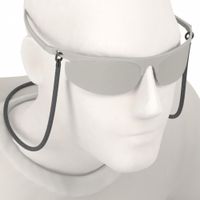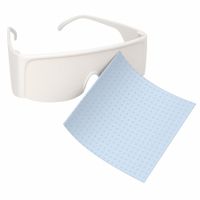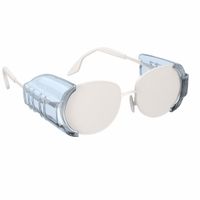Call +(254) 703 030 000 / 751 483 999 / 721 704 777
- Home
- Safety
- Eye Protection
- Safety Eyewear Cleaning Storage Accessories
.....Read More
Frequently Asked Questions
What are the best cleaning solutions for safety eyewear?
The best cleaning solutions for safety eyewear are those that effectively remove dirt, debris, and smudges without damaging the lenses or coatings. Here are some recommended options:
1. **Lens Cleaning Solutions**: Specifically formulated for eyewear, these solutions are safe for all lens types, including those with anti-fog or anti-scratch coatings. They effectively remove oils and fingerprints without leaving streaks.
2. **Mild Soap and Water**: A mixture of mild dish soap and lukewarm water is a simple and effective cleaning solution. It gently cleans without harming the lens coatings. Rinse thoroughly and dry with a microfiber cloth to avoid scratches.
3. **Pre-Moistened Lens Wipes**: These are convenient for on-the-go cleaning. They are pre-soaked in a gentle cleaning solution that is safe for all lens types and coatings. Ensure they are alcohol-free to prevent damage.
4. **Microfiber Cloths**: While not a liquid solution, microfiber cloths are essential for drying and polishing lenses after cleaning. They are designed to lift dirt and oils without scratching the surface.
5. **Commercial Anti-Fog Cleaners**: For eyewear with anti-fog coatings, use cleaners specifically designed to maintain this feature. These solutions clean while preserving the anti-fog properties.
Avoid using household glass cleaners, alcohol, ammonia, or vinegar, as these can strip coatings and damage lenses. Always follow the manufacturer's instructions for cleaning and maintenance to ensure the longevity and effectiveness of your safety eyewear.
How should safety glasses be stored to prolong their lifespan?
To prolong the lifespan of safety glasses, they should be stored properly to prevent damage and maintain their protective qualities. First, always store safety glasses in a clean, dry place away from direct sunlight, as UV rays can degrade the materials over time. Use a protective case or pouch to shield them from dust, scratches, and impacts when not in use. Ensure the case is lined with a soft material to prevent lens abrasion.
Avoid placing safety glasses in areas with extreme temperatures, such as near heaters or in vehicles on hot days, as this can warp the frames or lenses. Keep them away from chemicals or solvents that could cause deterioration or discoloration. If the glasses are used in environments where they may become contaminated, clean them before storage using a mild soap and water solution or a lens cleaner specifically designed for eyewear. Dry them with a soft, lint-free cloth to prevent scratches.
When storing multiple pairs, ensure they are not stacked or placed in a manner that could cause them to rub against each other. Use a dedicated storage rack or compartmentalized drawer to keep them organized and easily accessible. Regularly inspect the glasses for any signs of wear or damage, such as scratches, cracks, or loose parts, and replace them if necessary to ensure continued protection.
By following these storage practices, you can extend the life of your safety glasses, ensuring they remain effective and comfortable for as long as possible.
What are the benefits of using lanyards with safety eyewear?
Using lanyards with safety eyewear offers several benefits:
1. **Convenience**: Lanyards keep safety eyewear easily accessible, reducing the time spent searching for them. This is particularly useful in environments where quick access to protective gear is essential.
2. **Prevention of Loss**: By attaching eyewear to a lanyard, the risk of misplacing or losing them is minimized. This ensures that workers always have their protective eyewear on hand when needed.
3. **Enhanced Safety**: Lanyards help ensure that safety eyewear is worn consistently. By keeping the eyewear within reach, workers are more likely to use them, thereby reducing the risk of eye injuries.
4. **Cost-Effectiveness**: Reducing the likelihood of losing or damaging safety eyewear can lead to cost savings. Fewer replacements are needed, which can be economically beneficial for companies.
5. **Comfort and Ease of Use**: Lanyards can be adjusted for comfort, allowing users to wear them around the neck without discomfort. This ease of use encourages regular use of safety eyewear.
6. **Versatility**: Lanyards can be used with various types of safety eyewear, making them a versatile accessory in different work environments.
7. **Customization and Branding**: Lanyards can be customized with company logos or safety messages, promoting brand identity and reinforcing safety culture within the workplace.
8. **Reduced Interruption**: In dynamic work environments, lanyards allow workers to remove and replace eyewear quickly without interrupting their tasks, maintaining workflow efficiency.
9. **Hygiene**: Keeping eyewear attached to a lanyard reduces the chances of it being placed on unsanitary surfaces, maintaining better hygiene.
Overall, lanyards enhance the practicality, safety, and efficiency of using safety eyewear in various settings.
How do dispensers help in organizing safety eyewear?
Dispensers help in organizing safety eyewear by providing a centralized, accessible, and efficient storage solution. They ensure that safety glasses are kept in a clean, orderly manner, reducing clutter and minimizing the risk of damage or contamination. By having a designated place for eyewear, dispensers make it easy for employees to locate and return safety glasses, promoting consistent use and adherence to safety protocols.
These dispensers are often wall-mounted or placed in strategic locations, such as near workstations or entry points to hazardous areas, ensuring that eyewear is readily available when needed. This accessibility encourages workers to wear protective eyewear consistently, thereby enhancing workplace safety.
Moreover, dispensers can be designed to hold multiple pairs of glasses, accommodating various styles and sizes to suit different users. This versatility ensures that all employees have access to appropriate protective gear, regardless of their individual needs.
By keeping safety eyewear organized, dispensers also facilitate inventory management. Supervisors can easily monitor the availability of eyewear and restock as necessary, ensuring that there is always an adequate supply on hand. This proactive approach helps prevent shortages and ensures compliance with safety regulations.
In summary, dispensers play a crucial role in organizing safety eyewear by providing a structured, accessible, and efficient storage solution that promotes consistent use, enhances safety, and facilitates inventory management.
What is the proper way to clean and maintain safety goggles?
To clean and maintain safety goggles properly, follow these steps:
1. **Preparation**: Wash your hands thoroughly to prevent transferring dirt or oils to the goggles.
2. **Rinse**: Hold the goggles under lukewarm running water to remove loose debris and dust. Avoid hot water as it can damage the lens coating.
3. **Cleaning Solution**: Use a mild dish soap or a specialized lens cleaning solution. Apply a small amount to your fingers or a soft cloth.
4. **Gently Clean**: Rub the lenses gently with your fingers or cloth in a circular motion. Pay attention to the edges and any crevices where dirt may accumulate.
5. **Rinse Again**: Thoroughly rinse the goggles under lukewarm water to remove all soap or cleaning solution residue.
6. **Drying**: Shake off excess water and gently pat the goggles dry with a clean, lint-free microfiber cloth. Avoid using paper towels or rough fabrics that can scratch the lenses.
7. **Inspect**: Check for any remaining smudges or spots. If necessary, repeat the cleaning process.
8. **Storage**: Store the goggles in a protective case or a clean, dry place away from direct sunlight and extreme temperatures to prevent damage.
9. **Regular Maintenance**: Inspect goggles regularly for scratches, cracks, or other damage. Replace them if they are compromised, as damaged goggles may not provide adequate protection.
10. **Avoid Harsh Chemicals**: Do not use ammonia-based cleaners, alcohol, or other harsh chemicals, as they can damage the lens coating.
11. **Anti-Fog Treatment**: If fogging is an issue, apply an anti-fog solution or use goggles with an anti-fog coating.
By following these steps, you can ensure that your safety goggles remain clean, clear, and effective in providing protection.
How can coating stations improve the longevity of lens coatings?
Coating stations enhance the longevity of lens coatings through precise application techniques and controlled environments. These stations ensure uniform coating thickness, which is crucial for durability. By maintaining consistent thickness, the coatings are less prone to wear and tear, thus extending their lifespan.
The controlled environment of coating stations minimizes contamination from dust and other particles, which can compromise the integrity of the coating. This clean environment ensures that the coatings adhere properly to the lens surface, reducing the likelihood of peeling or flaking over time.
Advanced coating stations utilize technologies such as vacuum deposition or spin coating, which allow for the application of multiple layers with high precision. These layers can include anti-reflective, scratch-resistant, and UV-protective coatings, each contributing to the overall durability of the lens. The precise layering ensures that each coating performs its function effectively without interfering with others.
Temperature and humidity control within coating stations also play a critical role. By maintaining optimal conditions, the coatings cure properly, enhancing their adhesion and resistance to environmental factors such as moisture and temperature fluctuations.
Furthermore, coating stations often incorporate quality control measures, such as real-time monitoring and inspection systems, to detect and rectify any defects during the coating process. This ensures that only lenses with coatings that meet stringent quality standards are released, thereby improving their longevity.
In summary, coating stations improve the longevity of lens coatings by ensuring uniform application, minimizing contamination, utilizing advanced technologies, controlling environmental conditions, and implementing rigorous quality control measures.
What are the recommended practices for keeping face protection clean and functional?
To keep face protection clean and functional, follow these recommended practices:
1. **Regular Cleaning**: Clean face shields and masks daily or after each use. Use mild soap and water or a disinfectant recommended by the manufacturer. Avoid harsh chemicals that can degrade materials.
2. **Proper Storage**: Store face protection in a clean, dry place away from direct sunlight and extreme temperatures. Use a dedicated container or bag to prevent contamination.
3. **Inspect for Damage**: Regularly check for cracks, tears, or other signs of wear. Replace any damaged face protection immediately to ensure effectiveness.
4. **Avoid Touching**: Minimize touching the face protection while wearing it. If adjustment is necessary, wash hands before and after touching.
5. **Follow Manufacturer’s Instructions**: Adhere to the care and maintenance guidelines provided by the manufacturer to ensure longevity and effectiveness.
6. **Use Appropriate Cleaning Agents**: For reusable masks, use a gentle detergent and warm water. For face shields, use a soft cloth with a suitable disinfectant.
7. **Dry Thoroughly**: Ensure face protection is completely dry before storing or reusing to prevent mold and bacteria growth.
8. **Replace Filters**: If using masks with filters, replace them as recommended by the manufacturer to maintain filtration efficiency.
9. **Avoid Sharing**: Do not share face protection with others to prevent cross-contamination.
10. **Handle with Clean Hands**: Always wash hands before putting on or taking off face protection to reduce the risk of contamination.
By following these practices, you can maintain the cleanliness and functionality of your face protection, ensuring it provides the intended level of safety.




